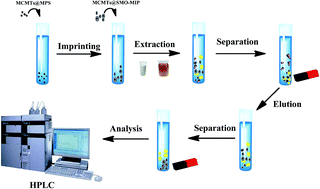Preparation of molecularly imprinted polymers based on magnetic carbon nanotubes for determination of sulfamethoxazole in food samples
Abstract
In this work, we present a general method to prepare core–shell molecularly imprinted polymers (MIPs) on the surface of magnetic carbon nanotubes (MCNTs@MIP) for sulfamethoxazole (SMO). The resulting MCNTs@MIP possess a highly improved imprinting effect, fast adsorption kinetics and high adsorption capacity, and can be applied to rapidly extract sulfonamide in milk and honey samples under an external magnetic field. The morphology, adsorption capacity and recognition properties of MCNTs@MIP composites were investigated by transmission electron microscopy (TEM), Fourier transform infrared (FT-IR) spectrometry, X-ray diffraction (XRD), vibrating sample magnetometry (VSM), thermogravimetric analysis (TGA), and re-binding experiments. The resulting MCNTs@MIP showed a good accessibility for the binding sites, a maximum adsorption capacity of MCNTs@MIP for SMO was 864.9 μg g−1, and a high selectivity toward the template molecule (SMO) in the presence of the structurally related sulfonamides (imprinting factor = 10.0). A method was developed for enrichment and determination of SMO in the milk and honey samples with recoveries ranging from 68.3 to 78.2% and 73.9 to 80.1%, respectively and relative standard deviations (RSD) < 6.8%.


 Please wait while we load your content...
Please wait while we load your content...